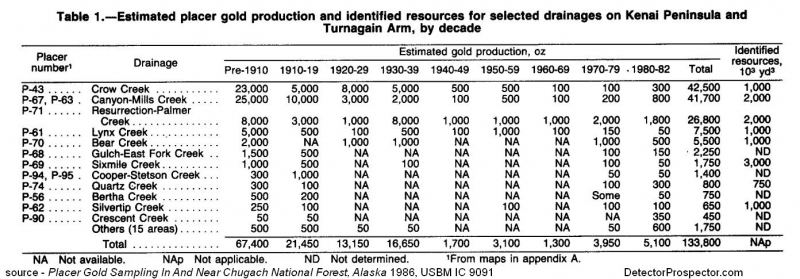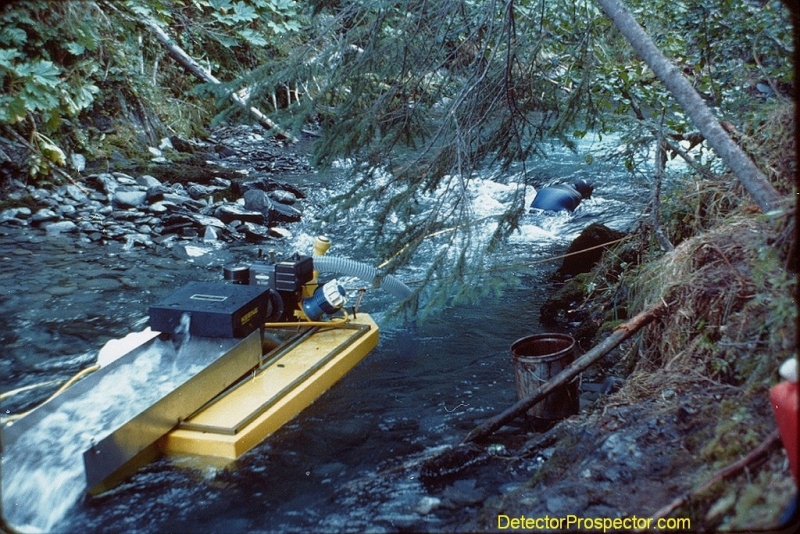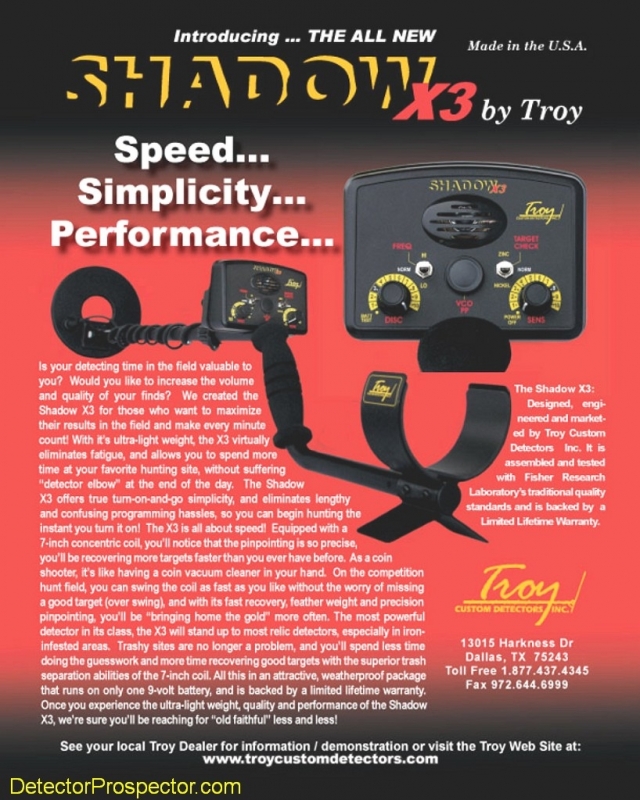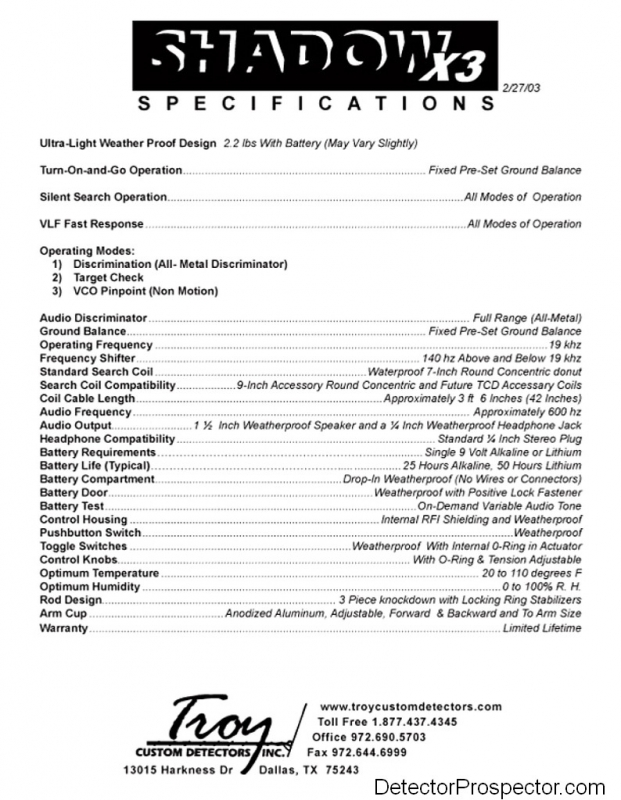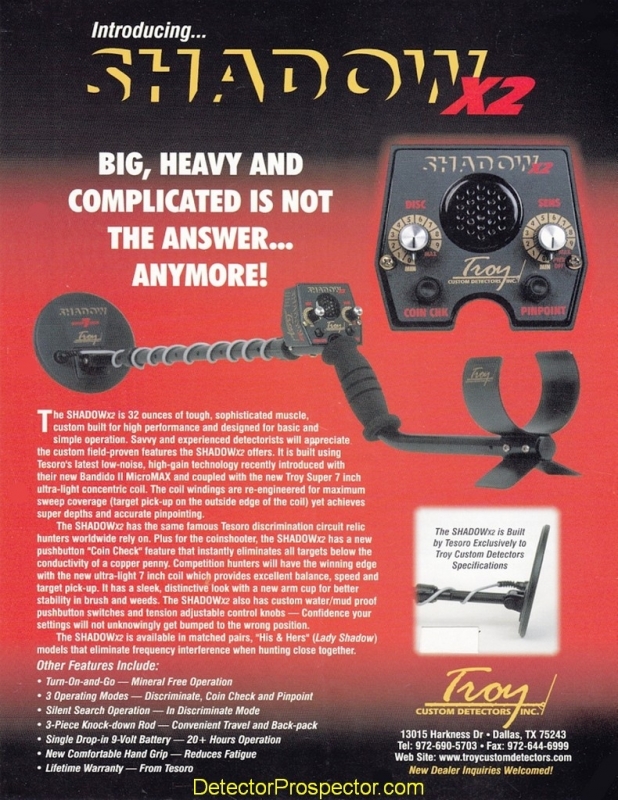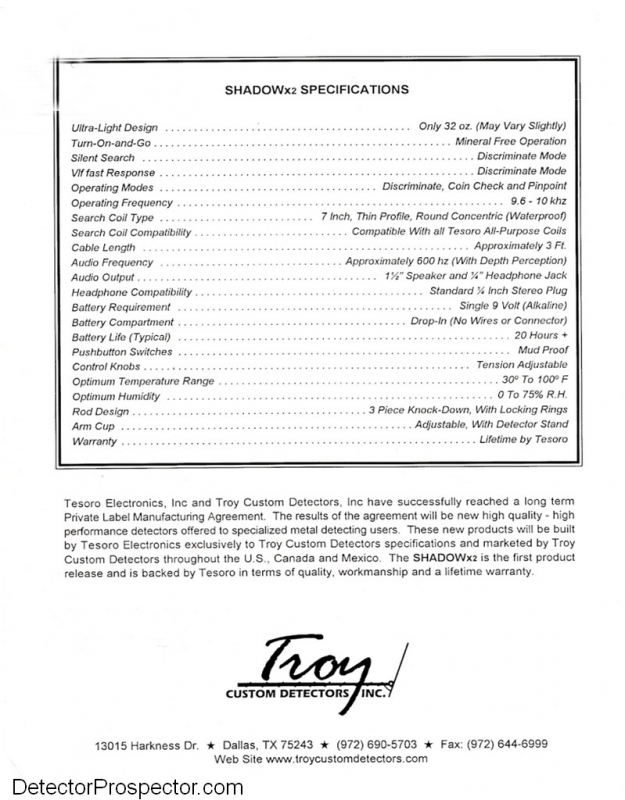-
Posts
19,790 -
Joined
Content Type
Forums
Detector Prospector Home
Detector Database
Downloads
Everything posted by Steve Herschbach
-
There is not one that I know of Fred. You can go to a new destination, restart your detector or turn off the navigation tool.
-

Is Garrett Coming To Town Today
Steve Herschbach replied to Ridge Runner's topic in Garrett Metal Detectors
"The Garrett offices are closed today. The work day in Garland Texas ended last night." As a small business person I worked plenty of days we were closed. I bet things are no different at Garrett. This one thread alone is just a sign of the methodology getting the desired effect. Garrett Facebook page.... -

Nokta Impact Finds
Steve Herschbach replied to Treasuredude's topic in Nokta / Makro Metal Detectors
Lots of people liking the Impact. Great finds Jeffery , thanks for posting! -

Is Garrett Coming To Town Today
Steve Herschbach replied to Ridge Runner's topic in Garrett Metal Detectors
Well, all they have really said is they will make an announcement on May 6 so a bit early to be writing them off. They never said 8AM. My assumption would be by end of work day in Garland, Texas. What is more fun is all the assumptions of what the announcement will be. It could simply be something like "new detector will be available by the end of the year" along with a few more tidbits about said detector. See Deus V4 release for reference. Or Garrett's very own ATX coils. Hopefully they do better than that. Like in something I can get in next month. -
Yeah, but he wants one that is V-rated, and no BigFoot coil is V rated except by accident. When you make an induction balance metal detector coil you have to null the coils. Induction balance infers two coils, a transmit and a receive coil, in a state off electrical balance, achieved by nulling the coils both by proper positioning and through tuning. A single frequency coil you only need to null to one frequency. A DFX BigFoot coil is nulled to 3 kHz and 15 kHz. The V3i runs at 2.5, 7.5, and 22.5 kHz. The null is working for 2.5 and 7.5 kHz but not at 22.5 kHz except by pure accident. This is usually seem by target VDI numbers tripling on the 22.5 kHz frequency when a DFX BigFoot is employed on the V3i. 2.5 kHz and 7.5 kHz single frequency work fine, but 22.5 single frequency and multifrequency modes exhibit odd behavior. Silver coins can read so high as to wrap around into the ferrous range. It can be a "feature" also as the low conductive range gets expanded. I have seen it claimed aluminum tends to respond differently than gold due to the 22.5 kHz being out of null but I have to admit to being skeptical on that. There may be demonstrable instances where that is true but when dealing with aluminum and gold it is the exceptions that get you. For me it was not so much getting the coil to run on the V3i as getting the detector to run the BigFoot, so I gave it a go with the V3i but sold the V3i and went back to the DFX purely to get proper operation on the high frequency. I wanted to run the BigFoot at 22.5 kHz single frequency but reality is 15 kHz single frequency on the DFX is good enough and no odd side effects. The improper null probably means improper ground balance settings are being achieved. If a person does run a BigFoot of the V3i, running 7.5 kHz single frequency works just fine. You can go multifrequency but it gets weird as the VDI numbers shift according to the dominant frequency. Some excellent commentary on V rated coils and how it applies to BigFoot "I get questions concerning the no longer produced Bigfoot coil. The problem isn't a lack of demand, or even a lack of manufacturing capacity. The problem is, because of the way Bigfoot is designed, it can't be simply extended to V3's specs. It would have to be completely redesigned. Even then, it might require a design change on V3I itself to get around certain limiting issues. Begging Jimmy to produce a V3I Bigfoot isn't going to make it happen, because it can't happen. Sorry. (CARL)" Coil Basics by Carl Moreland
-
Apparently turning the detector off is an option. I guess if it was bothering you then you could also just turn off the navigation tool.
-

Is Garrett Coming To Town Today
Steve Herschbach replied to Ridge Runner's topic in Garrett Metal Detectors
Nothing yet. I guess technically speaking they have until midnight in Alaska to be on time. Probably just boosting hits to their website and Facebook pages by holding off... -
The answer I have seen most often is that a detector running at a single frequency has an edge for technical reasons over machines running at multiple frequecncies. You will note that Minelab does not market their multifrequency machines for prospecting but instead offer machines running at single frequencies, though some Minelab models like the Eureka Gold do allow you to chose the frequency just like the Deus. Fisher sells the multifrequency CZ-3D but again does not market as a prospecting detector. Instead you are offered the single frequency Gold Bug Pro or Gold Bug 2. Note that Minelab's latest, the Gold Monster 1000, runs at a single frequency. From the Tesoro website at http://www.tesoro.com/info/faq/generaldetecting/ "Tesoro detectors use an LC or tank circuit to generate operating frequency. A capacitor and an inductor are paired together and create a naturally occurring efficient frequency. Variation in the capacitor and inductor cause slight variations in the operating frequency, which reduces the likelihood of crosstalk with other Tesoro machines. The variation is small enough that it does not affect the performance of the detector. The tank circuit described above generates a sinusoidal or SINE wave form. The SINE wave is efficient to generate and has no harmonics. Two frequency machines may combine a pair of SINE waves but are more likely to use a square wave. Multi-frequency machines almost always use a square wave or modified square wave. Square waves are rich in harmonics and take more battery power to generate. Harmonics generated by a square wave can be counted as individual frequencies and can be used to give more information as to target type and depth." From notes on using the White's V3i in mineralized ground http://forums.whiteselectronics.com/showthread.php?62484-Hunting-In-Mineralized-Ground-with-V3i "3-Frequency: Uses all three frequencies to report data and audio information. This selection will be the best on target data reliability reported as it is using all three frequencies to classify the target. In mineralized ground this can be very useful as targets respond differently on signal strength at each of the different frequencies so that there is a better probability of calculating the correct VDI of the target. Not as sensitive as when using a single frequency but with turning the sensitivity gains up it can be almost as good as in mineralized ground, the ground usually will be the determination of how deep the detector will go. However, using single frequency of 22.5 kHz will do better on small targets (gold chains) than the 3 frequency mode and the 22.5 kHz will also make the small foil sound better as this is the trade off." And finally, from Dave Johnson at https://www.tekneticst2.com/the-tek-files/the-history-of-metal-detectors-with-emphasis-on-gold-prospecting "The 1990’s also saw the introduction of multiple frequency metal detectors. This technology proved itself well for saltwater beach work, and for coinshooting and relic hunting requiring target identification and discrimination. However multiple frequency technology is not by its nature particularly sensitive to small metal objects, and that kept it from having any impact on gold prospecting."
-
It is hard to start with a high performance race car when you never driven before. You are on the right track - back off the sensitivity, a lot! You need to make life easier and have the detector running as smooth as possible. As far as digging lead and foil - if you are not you are really doing it wrong. Every foil or bullet target tells you that you are running your machine correctly. The smaller and deeper the foil and lead bits, the better you can consider yourself to be doing. Flip it around, dig them and tell yourself "could have been a nugget" and go dig some more. The only thing target id is possibly good for is telling you that you have a ferrous target, and even then it is not 100% reliable. If the target id bangs hard on 21 over and over, it is almost assuredly ferrous. Dig everything else until you learn the machine better. From my review at http://www.detectorprospector.com/forum/topic/1387-detailed-review-of-makro-gold-racer-by-steve-herschbach/"All Metal is the heart and soul of nugget detecting, and the Makro Gold Racer has an extremely powerful, smooth, and sensitive threshold based all metal mode. The Sensitivity setting is familiar to anyone who has used a metal detector, except that there are three base levels of sensitivity or gain. Significant boosts occur between 39 - 40 and again between 69 - 70. Most detectors max out at what is a setting of 69 on the Gold Racer. Settings of 70 and above are a type of hyper gain setting that takes the machine above and beyond, but in extreme ground overload signals may occur. Overload signals are indicated by a “warning siren” audio and the machine is telling you that there is either a large metal object under the coil, or that you are encountering extreme mineralization. In the case of mineralization, either raise the coil slightly while scanning, lower the sensitivity setting, or both. Overloads occurring at 70 will almost always be eliminated by dropping to 69.Rest assured very little is lost by lowering sensitivity to 69 or below, again, because many detectors cannot be set as hot as the Gold Racer even at their maximum setting. Do you ever run detectors and have the distinct feeling some performance has been left on the table, because the detector can always be run at maximum settings? Makro has given you that extra power for where it can be used, but in doing so they expect you will lower settings in places where that extra power works against you. Luckily, the audio alert makes it easy to know when this is. Most people do not know it but many detectors simply shut down and quit working under similar conditions with no indication at all to the operator, a situation referred to as “silent masking”." Be patient, it takes lots of that. The truth is that unfortunately some ground was just made for a PI and running a VLF on that type of ground can challenge the best of operators.
-

Dredge Tips
Steve Herschbach replied to Bear's topic in Gold Panning, Sluicing, Dredging, Drywashing, Etc
Great looking blaster you have there Bear! That was one dredging tool I never really employed as the places I worked did not require it. -
Everyone needs to watch this video. We talk all the time how lower frequencies ignore ground better and penetrate deeper on larger targets, but how high frequencies are better at getting small targets to respond. This video does a superb job of illustrating how high frequencies do a better job at "lighting up" a small gold target. The key is we are using one detector and coil with all the settings just the same - the only thing that changes is the frequency. This eliminates other extraneous factors that usually play into comparisons of this sort. What this video does not show is how higher frequencies not only "light up" the target but also mineralized ground, creating difficulty with penetrating deeply in that ground. One of the great lessons in metal detecting is that there is no free lunch, and very often improving one thing comes at a cost somewhere else. You can skip right to "the good part" at 2:45
-

New Detech Chaser Metal Detector
Steve Herschbach replied to argyle's topic in Metal Detector Advice & Comparisons
There appears to be only one DeTech Chaser model at this time, the 14 kHz version. Detech USA 114 McGrogan Rd Ruffs Dale PA 15679 Phone Line 1: (724)-446-9433: Phone Line 2: (724)-989-0341: Hours: Monday - Friday 8am - 5pm EST Email http://www.detechusa.com/contact-us/ -

Troy X5 Review By Steve Herschbach
Steve Herschbach replied to Mark Gillespie's topic in Metal Detector Advice & Comparisons
-

Troy X5 Review By Steve Herschbach
Steve Herschbach replied to Mark Gillespie's topic in Metal Detector Advice & Comparisons
The X2 was made by Tesoro and the X3 and X5 were made by Fisher (see X5 brochure above). They all in theory carry a Limited Lifetime Warranty to the original owners through Tesoro and Fisher respectively, but realistically that may be getting difficult due to unavailability of older parts. Click on images for larger versions. -
One last point before I move on to other subjects. The use of advanced geophysical devices is not as simple as people like to imagine. Ground penetrating radar for example. People imagine a screen with a pretty picture of the target. Reality is a small color squiggle or squiggles in the middle of lots of other squiggles. These devices results are highly interpretive and require trained, skilled operators. Please examine this document carefully because the included illustrations are highly informative. A REFERENCE FOR GEOPHYSICAL TECHNIQUES AND APPLICATIONS
-
An extremely large iron meteorite might be discovered with a low flying helicopter employing airborne magnetometers. I am guessing the meteorite would have the size of a small car or larger. Since the largest known intact meteorite is 2.7×2.7×0.9 metres (8.9×8.9×3.0 ft) the odds here are pretty low. Probably as good as my finding that one gallon sized gold nugget. This would be similar to Marine Magnetometer Surveys and would have similar parameters. Magnetometers do not work on non-ferrous metals like gold. The Hoba Meteorite
-
The irony in your post Jason is what you are saying sounds just like what purveyors of LRL instruments say. "the idea of long distance detection is not beyond the realm of scientific reality". The only difference is they claim to have discovered solutions to the issues you discuss, but cannot reveal how exactly in order to protect their proprietary methodology. After all, Fisher is not about to release the source code for the F75, are they? The key is pure common sense. This forum is a good example of a gathering place of successful prospectors from all over the world. As a whole the prospectors of the world try every single method available in a quest to succeed. One need merely examine the many forum posts over the years to find out who the successful prospectors are and what kind of devices they are using. It really is no more complicated than that.
-
Obviously a good person exists under your gruff exterior! Well done!!
-
You hit the nail on the head Norm. Long Range Locators or LRL tends to refer to a certain class of "belief based" treasure hunting device. Yet as Chris notes there are many "science based" devices that work at greater distances than are the norm in the hand held metal detectors that we usually discuss here on the forum. These fall under a class I refer to as "geophysical prospecting devices" used in exploration geophysics. From Wikipedia: "Exploration geophysics is an applied branch of geophysics, which uses physical methods, such as seismic, gravitational, magnetic, electrical and electromagnetic at the surface of the Earth to measure the physical properties of the subsurface, along with the anomalies in those properties." This 1995 paper from the U.S.G.S. briefly summaries the state of the art in table form with range to target in the column on the right. Click on image for larger version. The classic problem is the same as what we face with hand held metal detectors. Small items can only be detected at relatively short distances, and larger items at greater distances. For example, a small gold nugget weighing under a gram might be detectable at one centimeter, whereas a gold nugget weighing several kilograms might be detected at one meter. In order to achieve detection depths exceeding a meter, the target has to be extremely large, so large that no single mass of gold exists that could be detected at that range. In the realm of science based treasure hunting devices two well proven detectors are the Fisher Gemini 3 and White's TM808. The TM808 chart does a good job of showing how large items have to be to be detected at realistically achievable depths using existing technology: If you are looking for a gold nugget the size of a compact car, it might be detected at 20 feet / 6 meters. I think we can all agree that is unlikely. Nuggets the size of a one gallon can do exist, and these might be detected as deep as 1.7 meters depending on their shape and orientation in the ground. This would be possible with devices such as the Minelab GPX 5000 with a very large coil or even the TM808 in milder ground conditions. Geophysical prospecting methods rely on the targets being far larger than any single gold nugget. A typical target might be a mineralized zone in the earth a kilometer in diameter. This makes geophysical prospecting devices other than standard metal detectors as discussed on this forum inapplicable for use when looking for items smaller than a one gallon can. People often mention ground radar, and the same issue exists. The distance to target or target resolution is tied to the size of the item sought, and the greater the range you wish to detect it, the larger the target must be. That is the science of it as we currently know it, and devices that claim to exceed this limitation are stepping outside the realm of known science at this time. My advice to everyone always is stick with known provable scientific methods and avoid items sold using pseudoscientific marketing. Geotech LRL Resource Gold From Water (and Other Mining Scams) Nevada Bureau of Mines and Geology Special Publication #22 HANDBOOK OF GEOPHYSICAL PROSPECTING METHODS FOR THE ALASKAN PROSPECTOR A REFERENCE FOR GEOPHYSICAL TECHNIQUES AND APPLICATIONS

